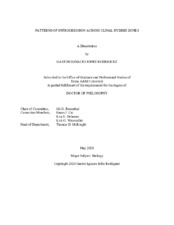| dc.description.abstract | A common goal in studies of natural hybridization is to understand how adaptation and speciation create genome-wide variation over spatial gradients. The speciation process generates genomic signatures that can be detected by tracking introgression along the hybrid zone. Geographic cline analysis is a framework that integrates spatial data to detect genome-wide patterns of divergence. In this dissertation I focus on geographic cline analysis to detect and compare patterns of genomic introgression in two natural independent hybrid zones formed by the freshwater swordtail fish Xiphophorus malinche- Xiphophorus birchmanni. Geographic cline analysis is widely applied to compare the cline shapes of multiple genomic regions to reveal signatures of selection. However, I show how hybrid zones in migration/drift disequilibrium can generate the detection of neutral regions as candidate targets of selection and can fail to detect regions under selection. Recent population sizes and migration rate estimates suggest that the X. malinche- X. birchmanni swordtail hybrid zones are amenable for detecting patterns of introgression. Using dense spatial sampling of swordtails along two independent hybrid zones, and geographic cline analysis on genome-wide markers of ancestry, I show that both hybrid zones have reduced amounts of genomic introgression, with steep genome-wide clines. The cline centers considerably differ in elevation, suggesting that geographic barriers and intrinsic selection are mainly shaping the hybrid zone structure. Additionally, I show that the centers of both hybrid zones have different hybrid index distributions, with one showing high admixture, and the other one showing population structure. Finally, I show that even with high amounts of selection against hybrids, some sexually dimorphic traits show transgressive expression while others show reduced introgression. Specifically, the X. malinche species specific sexual ornament, the sword extension, shows introgression of the “sword less” phenotype from X. birchmanni to X. malinche skewed hybrid localities. Together, my dissertation argues how geographic cline analysis is a powerful tool to detect introgression and selection in young hybrid zones, sheds light in how physical barriers and assortative mating can influence hybrid genomic and phenotypic distributions. | en |


